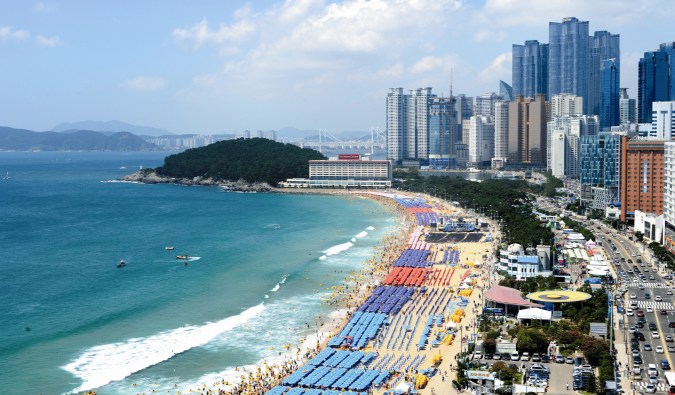Tour Program
Half day Seoul city tour
Itinerary
Pick up 01:30 PM(in front of the guest house Building 308) -> Cheongwadae Sarangchae -> Gyeongbokgung Palace (The National Folk Museum) -> Gwanghwamun Square -> Cheonggye Stream -> N Seoul Tower (Observatory included) -> Dinner at Myeong-dong (tteokgalbi -grilled rib patties) -> Drop off 09:00 PMTour Condition
Inclusion : English tour guide, Transportation, Admission Fee, DinnerExclusion : Personal expense
Time : 13:30 ~ 21:00 (7.5 hours)
Tour Price
$76 per personProgram
- Cheongwadae (Blue House) Sarangchae is a comprehensive tourist promotion center designed to enable visitors to understand the historyof former Korean presidents and Korea’s traditional culture.
- Gyeongbokgung Palace was the first royal palace built by the Joseon Dynasty. It was located at the heart of newly appointed capital of Seoul and represented the sovereignty of the Joseon Dynasty.
- The National Folk Museum of Korea displays the culture and folk history of the Korean people from prehistoric times to the end of the Joseon Dynasty. It is situated in the precinct of Gyeongbokgung Palace which is the main palace of the Joseon Dynasty.
- Gwanghwamun Square : On August 1st, 2009, the redesigned Gwanghwamun Square opened to the public. With the inauguration of the square, Sejong-ro, located at the center of the 600-year-old historic city of Seoul, was transformed into a human-centered space that harmonizes with the beautiful scenery of Gyeongbokgung Palace and Bukaksan Mountain.
- Cheonggye Stream : Koreans call Chunggyecheon as an oasis in the city central that is awakened from a long sleep. Among the dense tall buildings’ line-up, one ray of water is flowing through the central. Chunggyecheon has become a resting and picnic place for office workers at their lunch time and weekends. This place is chosen as the most beautiful ‘100 roads’ in Korea, it is really good for taking a stroll during a warm sun shining day.
- Namsan Seoul Tower was the first tower-type tourism spot in Korea. The top of the tower is at almost 480m above sea level, including Namsan Mountain (243m) and the tower’s own height (236.7m), making it one of the tallest towers in the Orient. The tower was first established as a broadcast tower to send out TV and radio signals in 1969. As of now, it has become one of the representative landmarks and multi-cultural venues in Seoul.
- Myeong-dong is one of the primary shopping districts in Seoul. Many brand name shops and department stores line the streets and alleys. Common products for sale include clothes, shoes, and accessories. Unlike Namdaemun or Dongdaemun, many designer brands are sold in Myeong-dong. In addition, several major department stores have branches here, including Lotte Department Store, Shinsegae Department Store, Myeong-dong Migliore, Noon Square and M Plaza. The department stores carry many premium labels and other fashionable goods at reasonable prices.
Full day Seoul vicinity tour
Itinerary
Pick up 09:00 AM(in front of the guest house Building 308) -> Suwon Hwaseong Fortress & Haenggung Palace(UNESCO Cultural Heritage Site) -> Lunch (Hot Stone Pot Bibimbap) -> Korean Folk Village -> Dinner at buffet restaurant -> Drop off 09:30 PMTour Condition
Inclusion : English tour guide, Transportation, Admission Fee, Lunch & DinnerExclusion : Personal expense
Time : 09:00 ~ 21:30 (12.5 hours)
Tour Price
$103 per personProgram
- The Hwaseong Fortress in Suwon is a fortress city built in the late Joseon Dynasty (1392-1910). Along with Changdeokgung Palace, the fortress was designated as a UNESCO World Cultural Heritage in December 1997. The total perimeter of the fortress spans 5.52 kilometers, with 50 or so structures along the walls. Among those, seven were destroyed as a result of wars or natural disasters, but the remaining ones are well preserved. Suwon Stream flows through the interior of Hwaseong Fortress. The Hwahongmun Gate is built above seven arched aqueducts that allow the water to flow through. Together with nearby Banghwasuryujeong Pavilion and Yongyeon Pond, Hwahongmun Gate is considered the most beautiful of the Hwaseong Fortress structures.
- Hwaseong Temporary Palace (Hwaseong Haenggung) is the biggest temporary palace in Korea and also well-known as beautiful as Gyongbokgung Palace. The 478th historical site Hwaseong Temporary Palace was built on the foot of Padalsan Mt. after building Suwon Sineupchi was finished in 1789(the year 13 of the reign of King Jungjo). It was used as a government office of Suwon and completed through expanded construction for 2 years during the construction of Hwaseong. King Jungjo who was very loyal enough to visit Yungneung Shrine(a mausoleum of the crown king who was the father of Jungjo) 13 times stayed in Hwaseong Temporary Palace during visit. The palace has a shape of King’s palace with 567 rooms and it is the biggest size among temporary palaces in Korea. But most facilities except Nangnamheon Hall were deconstructed by the policy to obliterate the Korean culture and history of nation during Japanese colonial era. And thanks for local residents who organized the restoration project committee and lead the drive to revival of the palace, it reopened to the public in October 2003 after the restoration since 1996. Hwaseong Temporary Palace is became the famous shooting set for Korean historical dramas in these days, provides demonstration performance of Muye 24ki, change ceremony of gate guards, court robes and traditional crafts experience.
- Korean Folk Village introduces traditional culture from the late Joseon period to both local and international visitors through cultural classes experience, shaman faith, seasonal customs and others. Also, the village shows various places with unique features such as a farming village, private house, official districts, Confucian academy, seodang (village school), and a village street in realistic descriptions, as well as, a nobleman’s house and traditional workshop.


